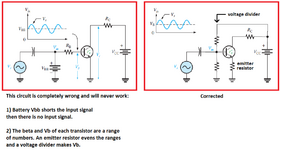libyantiger
Member level 5
hello
what i know
it is well understood that a transistor amplifeir is firstly done by fixing the transistor some where in the active region where basically the transistor is
never full on nor fully off
and in between transistor which have some current flow some voltgae across e and c is ready for amplifications usually when vcc is 10vdcs ic when transistor is fully on is 1 amp
the best point is 0.5 amps and 5vdc the word "fixing transistor " means tweaking value of resistor some how to put the transistor in this active region
when the ac signal applied it "ride " on dc lever cause change in base voltage which change base current which change collector current hugly which is what amp is really is
what i dont know
my
first question how on earh in the figure this ac is on top of the dc it is picture taken form the floyd book very respectable book and to my maximum torture is that the autor have utilized " my theory " of ac source on the dc source in some examples but then back to use the less obvious method of using the ac source in parralell wiith dc if some one can ezplain how that can be called an amplifications i never connect to dc or ac source in parrallell and willl never try or calculate what happen after that
my
second question
if all text book can utilise ,my "theory " of putting the ac signal source on the dc evern the most difficult method of basing can understood pls check and verify my understanding
of the common base baising
in common base the emiitter resistor "govern" the ie it is what determine the ie giving by kerchov law across base emitter and the vcc -5 volt the ie have been decided
any ac voltage acrosss the the input will increase ie or decrease it >>>>>ic is almost equall to ie so no current amplification will result however
voltage amplification can happen since ic and ie almost equal then if large out put resistor will reustl in large voltage swing across it which is what common base is used not current amp but voltage amp

thanks i believe i have flaw in my understanding but i dont know where
what i know
it is well understood that a transistor amplifeir is firstly done by fixing the transistor some where in the active region where basically the transistor is
never full on nor fully off
and in between transistor which have some current flow some voltgae across e and c is ready for amplifications usually when vcc is 10vdcs ic when transistor is fully on is 1 amp
the best point is 0.5 amps and 5vdc the word "fixing transistor " means tweaking value of resistor some how to put the transistor in this active region
when the ac signal applied it "ride " on dc lever cause change in base voltage which change base current which change collector current hugly which is what amp is really is
what i dont know
my
first question how on earh in the figure this ac is on top of the dc it is picture taken form the floyd book very respectable book and to my maximum torture is that the autor have utilized " my theory " of ac source on the dc source in some examples but then back to use the less obvious method of using the ac source in parralell wiith dc if some one can ezplain how that can be called an amplifications i never connect to dc or ac source in parrallell and willl never try or calculate what happen after that
my
second question
if all text book can utilise ,my "theory " of putting the ac signal source on the dc evern the most difficult method of basing can understood pls check and verify my understanding
of the common base baising
in common base the emiitter resistor "govern" the ie it is what determine the ie giving by kerchov law across base emitter and the vcc -5 volt the ie have been decided
any ac voltage acrosss the the input will increase ie or decrease it >>>>>ic is almost equall to ie so no current amplification will result however
voltage amplification can happen since ic and ie almost equal then if large out put resistor will reustl in large voltage swing across it which is what common base is used not current amp but voltage amp
thanks i believe i have flaw in my understanding but i dont know where
Last edited:
